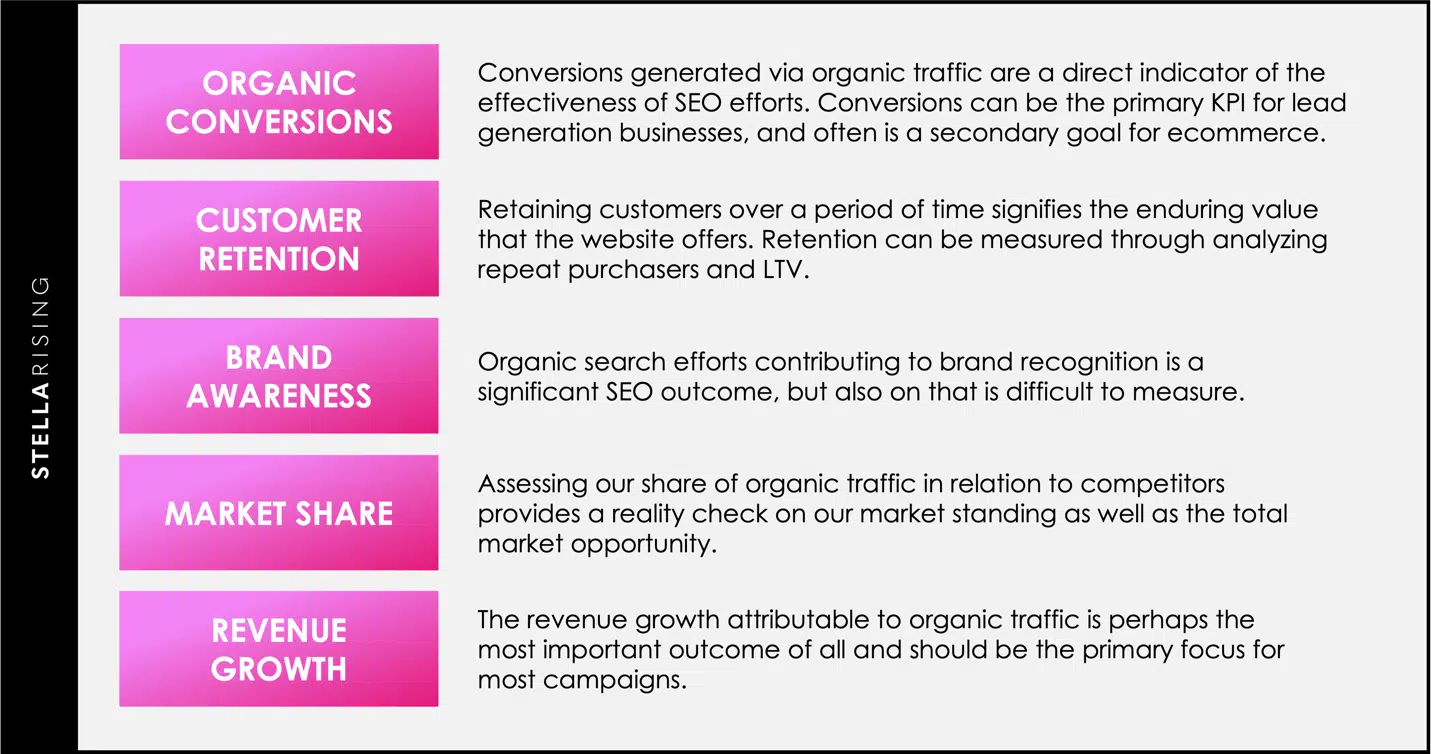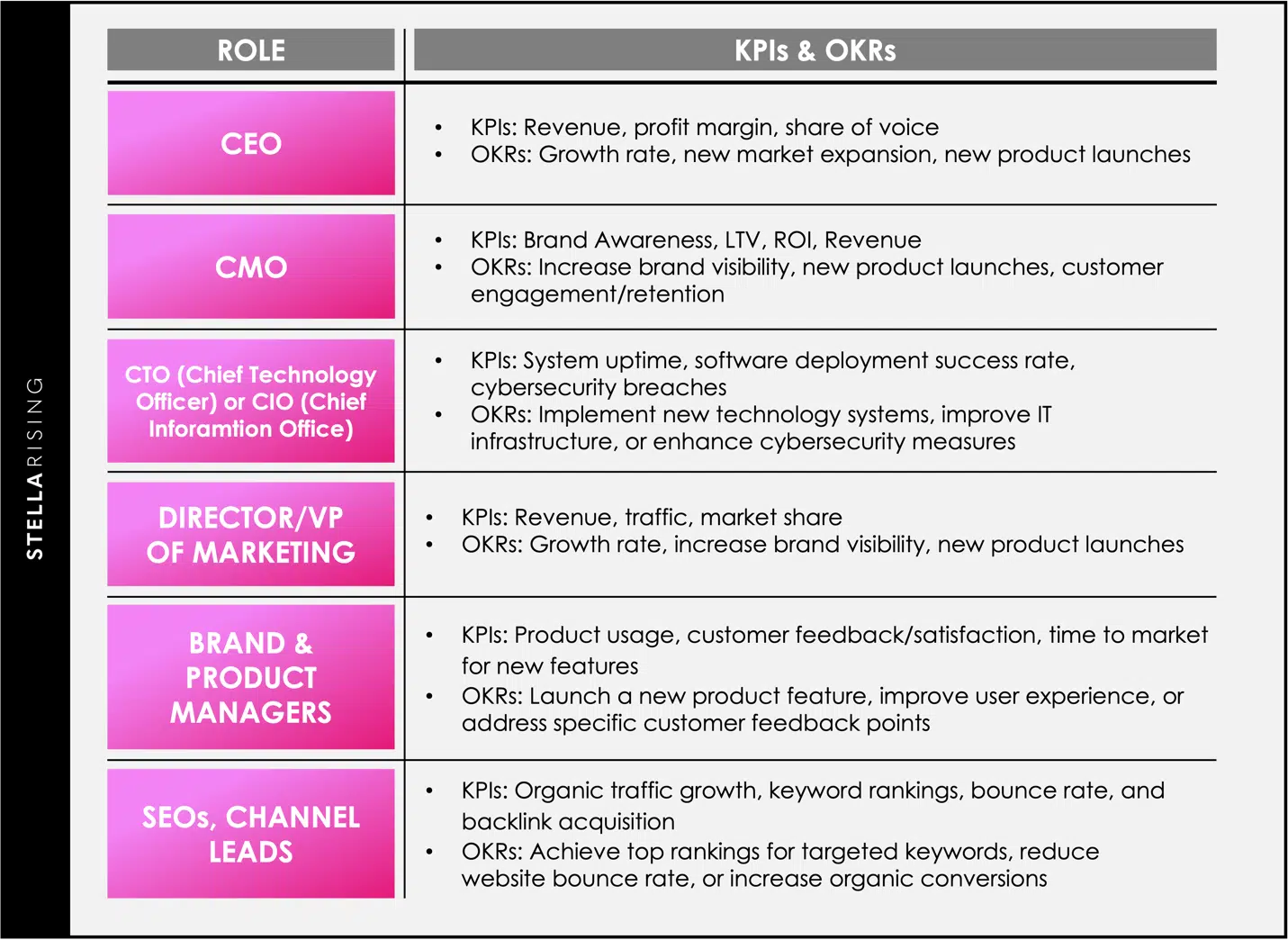It’s all too easy to get caught in the web of metrics, algorithm updates, and new SERP features. But what if we’re chasing shadows?
The real purpose and benefit of SEO isn’t just increasing pageviews or optimizing keywords – it’s about aligning with the true north of business goals and helping to achieve them through search.
A myopic focus on inputs, outputs, and details that may or may not move the needle often leads SEOs to miss the forest for the trees.
A simple mindset shift can make a massive impact on your work as an SEO. Focusing your SEO program on outcomes vs. outputs while effectively communicating those outcomes to the right stakeholders can drastically improve your ability to drive results.
SEO outputs vs. SEO outcomes: How do they differ?
Outputs refer to the tangible and measurable deliverables produced from SEO efforts.
The outcomes are the effects of those outputs as they relate to a business goal, such as increasing new customers. These desired outcomes could include:
- Increased brand visibility online.
- Higher conversion rates from visitors to customers.
- Better user experience on a website.
- Ultimately, more revenue for a business.
Another way of thinking about outcomes is considering the problems to be solved: will solving the problems ultimately achieve the goals set forth by the business?
When building an SEO strategy, it is critical to focus first on the desired outcomes and then on the outputs needed to achieve those outcomes.
Merely tracking outputs, without an eye on the larger business objectives, can sometimes miss the mark in achieving company goals.
Dig deeper: SEO KPIs to track and measure SEO success
Examples of SEO outputs
With any SEO effort, it’s important to understand the work that needs to be done in a quantifiable way and then to implement early channel signal indicators so as to understand that efforts are having an impact.
For example, if we work on an ecommerce site that sells socks with 100 pages:
- Optimizing 50 of those pages in a first pass is a measure of input.
- The ranking increases for those pages are an output.
- The new customer growth resulting from those improvements is an outcome.
Here are examples of common SEO outputs:
Traffic metrics
- The growth of organic visitors to a site, as measured through metrics like page views and sessions, serves as a primary indicator of the website’s visibility in search.
- Tools like Google Analytics can provide a detailed view of these metrics, shedding light on user behavior and interest.
Ranking
- The positions your keywords have in the search engine result pages (SERPs) directly correlate to your site’s potential to attract organic traffic.
- Tools like Semrush or Moz can help track and analyze these rankings.
Backlinks
- The number and quality of backlinks pointing to a site reflect its perceived value and authority in the digital ecosystem.
- Tools like Ahrefs can aid in monitoring backlink profile, ensuring a healthy, growing link portfolio.
Technical SEO metrics
- Metrics like site speed, numbers of 404/301 errors, pages without canonical tags and other technical scorecard metrics play a role in user experience and search engine ranking. However, reducing these numbers is not always correlated with performance increases.
Examples of SEO outcomes
SEO outputs are the stepping stones – SEO outcomes are the destination.
Outcomes mirror the long-term value and impact that our SEO strategies imprint on the business landscape.
Organic conversions
- Conversions generated via organic traffic are a direct indicator of the effectiveness of SEO efforts.
- Conversions can be the primary KPI for lead generation businesses, and often is a secondary goal for ecommerce.
Customer retention
- Retaining customers over a period of time signifies the enduring value that the website offers.
- Retention can be measured through analyzing repeat purchasers and LTV.
Brand awareness
- Organic search efforts contributing to brand recognition are a significant SEO outcome, but also difficult to measure.
Market share
- Assessing our share of organic traffic in relation to competitors provides a reality check on our market standing as well as the total market opportunity.
Revenue growth
- The revenue growth attributable to organic traffic is perhaps the most important outcome and should be the primary focus for most campaigns.

Get the daily newsletter search marketers rely on.
Measuring and reporting on what matters
While “measure everything” is a great credo to live by, “report on everything” is not.
As a channel expert, you live in the data, but the stakeholders whose favor you need do not.
Stakeholders are busy with many other things, with their time and priorities in demand. Your initiatives will get lost if you do not report on what matters.
Critical attention from decision-makers is why it is so important to measure and report on what really matters to organizations.
The table below shows the KPIs and OKRs that people at each level of an organization may be interested in learning about from an SEO.

These are general KPIs and OKRs for each role, and they can vary based on the specific nature of the business, industry, and organizational goals.
Ultimately, at each level of the organization KPIs and OKRs support those of the CEO.
Dig deeper: How to determine the SEO metrics that matter
Mapping your SEO work to outcomes that support organizational OKRs
One of the best things you can do to enrich any client relationship or interdepartmental, internal-stakeholder relationship is to ask questions that drive at the heart of your partner’s or colleagues’ goals.
Your mission is to help them achieve their mission. If you can clarify that while asking the right questions, opportunity and growth unlock.
Ask your colleagues or partners what objectives are on their roadmap. Ask the same for the CEO and the leadership team. Understand the goals for the year and the quarter. Then, in planning your SEO efforts, ensure you align with those goals.
Outcome-driven SEO gets bigger results, sometimes faster than SEO focused on a volume of outputs and checking boxes.
Ultimately, SEO roadmaps that are outcome-driven and align with organizational goals tend to be the ones that get executed and fully implemented, thus delivering the full benefit of the work.
The more you align your SEO roadmap to the shared vision of the team you are a part of, the more partners you can get on board to help you.
Dig deeper: How to create SMART SEO goals (with examples)
Putting this into action
Identifying outputs from outcomes is critical for SEOs to align their strategies with overarching business objectives.
While channel metrics like keyword rankings, impressions, and even clicks are all measurable impacts and outputs of SEO, it is ultimately outcomes that businesses are after.
By shifting the focus of your work from output-focused to holistic and impact-oriented, you will align your work with the business objectives.
An outcome-driven approach to SEO prioritizes what matters to an organization while ensuring that the work that gets prioritized is robust and focused. Meaningful results will follow!
By intertwining SEO roadmaps and efforts with organizational goals and meticulously mapping them to desired outcomes, SEO can demonstrate its true potential as a tool that holistically propels businesses toward achieving their true north goals.
Opinions expressed in this article are those of the guest author and not necessarily Search Engine Land. Staff authors are listed here.








